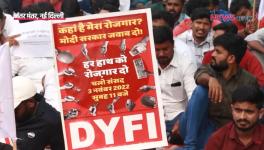India on the Brink of Unprecedented Unemployment Crisis: CMIE Report
Analysing a recent report on unemployment in India by the Centre for Monitoring Indian Economy, GYAN PATHAK warns about the looming unprecedented unemployment crisis.
THE real extent of the economic damage from last year is now in the open. The biggest loss of employment in 2020-21 was suffered by salaried employees as opposed to the popular belief that they were the safest in terms of security of employment and earning during the COVID-19 lockdown and subsequent restrictions of last year. The situation is most likely to further deteriorate in the absence of any comprehensive job retention programme, and the latest round of restrictions on people and businesses being imposed by authorities across the country in response to the second deadly nationwide coronavirus wave.
The latest Centre for Monitoring Indian Economy (CMIE) report reveals that salaried jobs across India registered a sharp decline in 2020-21 to the tune of 9.8 million. India had a total of 85.9 million salaried jobs in 2019-20 which, by the end of March 2021, reduced to 76.2 million.
This clearly indicates that all the initiatives of the Union Government for the creation and retention of secure jobs failed, most likely due to the ad hoc and hurried nature of these initiatives. It is fervently hoped that the government clearly learns from its failure and prepares a better strategy for the road ahead.
The present surge of COVID-19 represents a grave threat to the livelihood of thousands of workers. Due to the assortment of lockdowns and curfews already in place in several parts o of the country to deal with the surge of infection, it is estimated that 57% of India’s total population was forced to remain indoors over the weekend.
Salaried job loss heavy in both urban, rural India
The present restrictions are majorly prevalent in urban India, where most of the salaried jobs are. According to employment data from 2019-20, urban India accounted for 58 % of all salaried jobs in the country. The job loss in urban India during 2020-21 was, however, only 38 % of the total job loss of 9.8 million, as per the CMIE report. This means that urban India will witness further salaried job loss over the course of the year.
Also read: Mr. Modi, Any Plan for the Economy?
Salaried jobs in rural India, accounting for only 42 % of all such jobs in India, bore the brunt of 62% of the total such jobs lost in 2020-21. In absolute terms, this equates to six million jobs lost. Further losses in rural salaried jobs may be less than that in urban India, but a threat is still looming large. In the second wave, smaller cities have been reported to have been far worse-hit than in 2020; this will almost certainly disturb the overall employment scenario in the rural areas adjoining these cities.
What happened to the employees who have lost jobs in the first COVID-19 wave? According to the CMIE report, most of them are likely to have migrated to farming. They would have joined the nearly three million businesspeople in rural India who were rendered unemployed, as per the report, and could also have migrated to farming.
This is validated in the job data, which show an increase of nine million jobs in the agriculture sector. Such a large shift of the newly unemployed from their old jobs to farming clearly indicates a heavy load on agriculture, which will be difficult to sustain without a substantial increase in agricultural productivity.
The report clarifies that this shift must not be seen as one from urban to rural areas, but from non-farm jobs in rural India to farming jobs. The increase in jobs in the agriculture sector in March 2021 supports this fact.
Also read: India’s Case for Universal Basic Income
The ramifications of large-scale migration of workers
Migration from urban areas to rural areas due to loss of jobs in cities has also increased the burden on the agriculture sector and rural India. Reports from the first fortnight of April 2021 indicate that a large number of people are migrating from urban to rural areas. This trend is further evidence of the job loss in urban areas among both the salaried and the non-salaried.
The majority of the migration in this second wave is happening from the urban areas of Maharashtra, Gujarat, and Delhi. Since most of the migrants are from Uttar Pradesh, Bihar and other eastern states, there could be a sharp rise in the number of unemployed people in those states when they would return, as well as adversely impact the economy of the states that the migrant workers are deserting.
Sectors like retail, catering, manufacturing, home service, etc. are already facing the heat. Transport and logistics are also being adversely affected. The disruption of production and supply has also begun and is likely to worsen in the coming days.
As previously discussed, the CMIE report shows that most of the loss of salaried jobs was registered in rural India. However, urban India still bore the loss 3.7 million salaried jobs from last year. New restrictions in urban areas are going to further reduce salaried employment in April and beyond.
Also read: Budget 2021- 22 Must Focus on Job Revival and Direct Funds to Poor
Scale of the unemployment crisis facing India
Lakhs of people who had lost their jobs in the first wave are yet to find employment, and they cannot hope to get it in the near future with the number of jobs diminishing fast. Finding any kind of new job in this scenario has become difficult, let alone decent jobs.
The wrecking of employment by the second COVID wave has made our economic recovery even more difficult. As per the CMIE report, labour participation in March 2021 was 40.2% as against 42.7% in 2019-20. Employment rate is also down to 37.6% as against 39.4% last year. The unemployment rate is at the-still high figure of 6.5 percent though, curiously, lower than 7.6% of 2019-20.
The CMIE report estimates that the present wave could add up to well over 120 million in job losses, which amounts to 30% of the total population employed across all sectors. Data from the first two weeks of April 2021 shows that the unemployment rate has risen to over 8%, with a 40% fall in the labour participation rate.
As of March 2021, the total employment figure in India was 398 million, which was 5.4 million lesser than the 403.5 million in 2019-20. This data, even though grave in itself, hides the much bigger casualty: that of people losing jobs and moving to other, often less productive and lucrative, jobs. About 8% of all employees migrated to agriculture, the productivity of which grew by only by 2-3%. It increased the employment count hiding the real loss.
It is imperative that the Union government analyse this data carefully, and address the crisis of unemployment urgently. (IPA Service)
The article was originally published in The Leaflet.
Get the latest reports & analysis with people's perspective on Protests, movements & deep analytical videos, discussions of the current affairs in your Telegram app. Subscribe to NewsClick's Telegram channel & get Real-Time updates on stories, as they get published on our website.
























